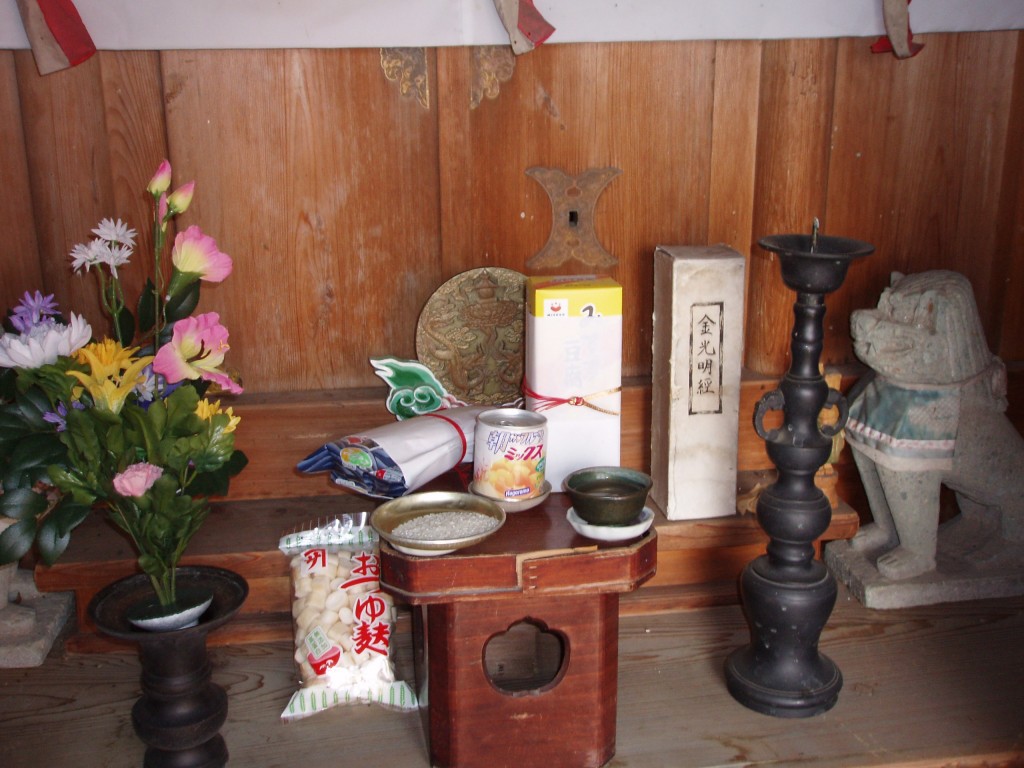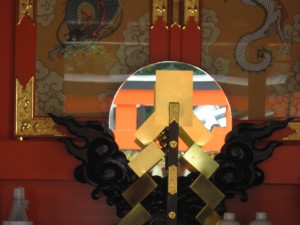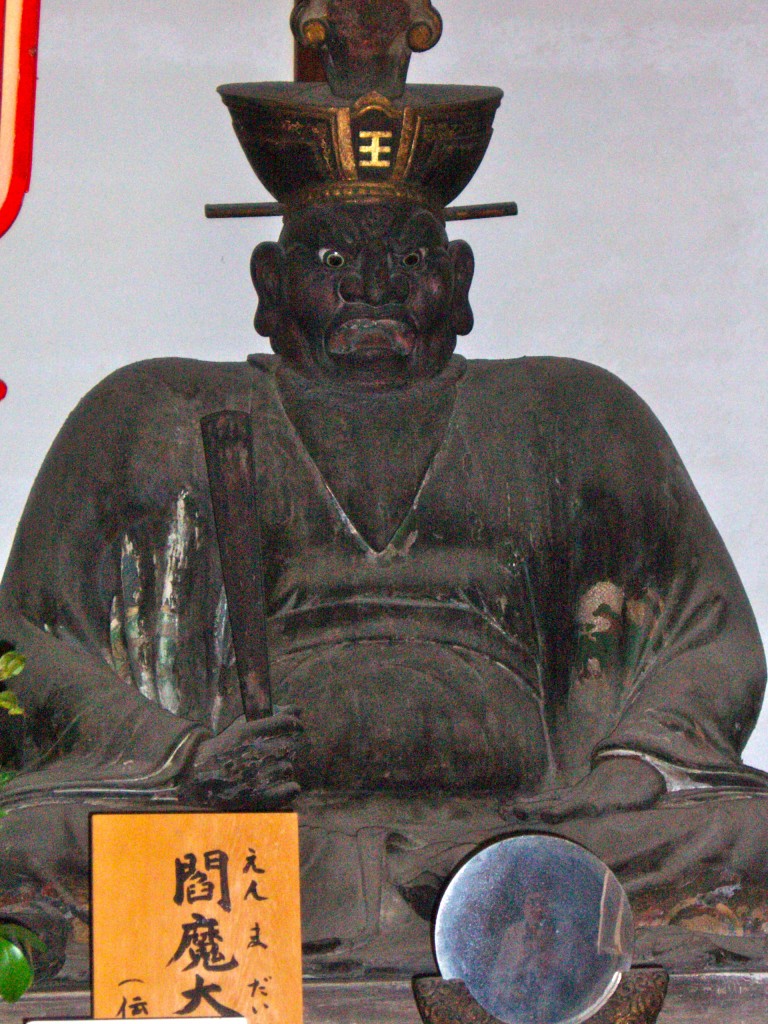
Buddhist altar with round mirror
On my visits to Buddhist temples, I’ve sometimes noticed round mirrors on the altars and wondered whether this was the influence of syncretic shin-butsu (Shinto-Buddhism). However, thanks to Green Shinto friend and polymath John Hanagan, I’ve now been able to trace this mirror back to Yogācāra (literally, “yoga practice”), an influential school of Buddhism focussing on internal perception which developed around the 4th century CE.
Yogācāra discourse examines how human experience is constructed by mind. One of the theorists, a fifth-century Indian called Vasubandhu, came up with the idea of eight levels of consciousness. The top level shines with the light of a wisdom like a great mirror… hence the expression in Buddhism of The Great Wisdom Mirror, or Great Perfect Mirror Wisdom, which reflects the universe as it really is, free of distortion from ego or ignorance.
The Buddhist mirror is thus intended to liberate the mind. It signifies that life is an illusion, for the mirror is not true reality — it is rather a reflection of reality. It is thus a metaphor for the unenlightened mind, which is deluded by mere appearances. Look and reflect upon reality!

The Shinto mirror, symbol of Amaterasu
In one of his paintings the Zen master, Hakuin (1686-1768), uses the mirror as a symbol of the Buddha-mind. How interesting then that Amaterasu, Shinto’s sun-goddess, should be represented by a mirror. It prompts one to wonder about the connections. The founding myths of Shinto were recorded in the late seventh/early eighth century, more than a hundred years after the introduction of Buddhism, and are clearly stamped with the influence of continental ideas.
Could Buddhist notions have played a part in the identification of Amaterasu with a mirror? The idea of marking her as both an enlightened being as well as an imperial ancestor must have been appealing to the mythologisers of the day. If so, it would fit in with current notions about early Shinto being akin to a branch of Buddhism.
Previously I’d always thought of the shamanistic mirror as lying behind that of Amaterasu. Now however the Great Perfect Wisdom Mirror has given me pause for thought – in more senses than one!

The Buddhist deity, Emma, lord of the underworld, who uses a mirror to examine the souls of those who come before him
Hakuin had this to say on the subject of Emma’s mirror: “In Emma’s court there is a Mirror of perfect clarity that reflects unfailingly the past misconduct and sins of the dead, but they do not learn about it and become repentant until after they have fallen into Hell, when it is too late. This mirror is in fact nothing other than man’s Storehouse Consciousness. When you break through this Consciousness at its very depths and grasp your original self, the Storehouse Consciousness becomes, in and of itself, the Great and Perfect Mirror Wisdom.” (tr. by Norman Waddell)

Just a comment on the mirror.
Round mirrors seem to have been the normal shape, maybe from polishing the brass in a circular motion. I used to think it was a symbol of the sun for the sun god Amaterasu-Omi-Kami.
When I was at the Shanghai Museum I purchased a small, brass replica mirror. It was a transparent mirror (Western Han 206 BC – AD 8).
As we can see our own image in a mirror it is not surprising that it is regarded as a magical object.
Thanks, Iandalf. It’s curious that mirrors were round, as you say, in order to facilitate the polishing, yet the circle is such a powerful suggestive symbol. Not only the shape of the sun and the earth, but with no beginning and end, etc.
Seeing our own image must have been magical enough, but as far as I understand it the authority of the mirror came from its use as a spiritual weapon, for it was thought to be able to ward off evil spirits. I would hazard a guess that this came from its ability to reflect the brightness of sunlight into even the darkest of places…
Naoko Sato has written in with some useful information as follows:
At Horyu-ji a lot of mirrors are donated to Saien-do. Saien-do is an octagonal pagoda, belonging to Houryuji temple in Nara prefecture. The original pagoda was built in the ancient period but the current one was made during the Kamakura period. Inside the pagoda there is a huge Yakushi nyorai (Bhechadjaguru: the Physician of Souls: the healing Buddha). As people believed that the Yakushi nyorai of Saien-do Pagoda had special powers for curing diseases afflicting the eyes, therefore a lot of mirrors were donated to Saien-do during the ancient era. People thought that mirrors symbolized clear vision because of the way they reflect light. Some of those donated mirrors date back to ancient times, and sometimes donors wrote what they wanted on the surface of the mirror.
Further information in Naoko Sato’s article ‘Gi-Kan Style Mirrors Dedicated at Saien-do of Horyu-ji’ in MUSEUM, The Bimonthly Magazine of the Tokyo National Museum 1996
Today I read in Andrew Harvey’s Journey in Ladakh that the Buddhist wisdom of emptiness is wisdom ‘like a mirror’…